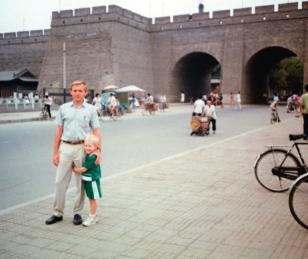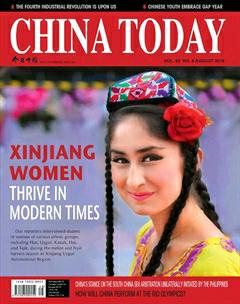Xi’an–Memories in a Letter Home
By BILL BROWN

I guess readers still remember the adventure I had in 1994, when Susan and I with our two boys traveled around China. Here is an extract from a letter home written on July 20, 1994 to my parents.
“Dear Mom and Dad, Were finally in Xian! It took three days to drive here from Hohhot in Inner Mongolia. We got stuck twice in the Gobi Desert. It was really scary!”
Our six-week drive from Xiamen to Xian was exhausting, but this extraordinary city was the highlight of our entire 40,000-km trip around China. The most ancient of Chinas four great capitals, more than 3,000 years ago Xian was a political and cultural center, and capital of the First Emperor of the Qin Dynasty(259-210 BC), who unified China and built the Great Wall.
I used to be pretty impressed with the 2.4 km city wall of Chongwu, built in the 14th century, just 90 minutes north of Xiamen. But compact Chongwu is a toy town compared to sprawling Xian. The first Xian wall, built 2,200 years ago, was 25 kilometers long and 12 to 16 meters thick at the base. When the 84 square kilometers walled city was rebuilt 1,500 years ago during the Tang Dynasty (618-907), it was the largest city on earth.
Xian was the bustling doorway to the Silk Road, and home to people of virtually every race and creed, including Chinas first Christians (635 AD) and first Muslims (about 650 AD), as well as a large Jewish community.
With such a long history, its no surprise that many of Xians greatest attractions are below ground. Xian has over 800 royal mausoleums, including that of the First Emperor of the Qin Dynasty, which was discovered by local farmers in 1974. So far, more than 8,000 terracotta soldiers have been unearthed at this 2,200-year-old site, whose nearby pits also contain statues of acrobats, musicians and officials. Each face is unique, with realistic facial features, and they were originally painted in vivid colors. Unfortunately, the lacquer paint flaked off these sculptures within four minutes of exposure to Xians dry air.
I was most amazed by the weaponry, including swords, scimitars and shields, and crossbows with a range of 800 meters. The swords were made of an alloy of copper, tin, nickel, magnesium and cobalt, and coated with an almost microscopic film of chromium dioxide that has fended off rust for 2,000 years.
Another favorite Xian site is the Stele Forest. Its 3,000 ancient steles include the Nestorian Stele, erected in 781 which, in Chinese and Syriac, recorded the arrival in 635 of the Christian bishop Alopen. For centuries, scholars suspected the stele was a fake until its claims were corroborated by the discovery of the Chinese Christian texts – the “Jesus Sutras” – which were sealed in Dunhuangs Mogao caves 1,000 years ago.
One of Xians most famous sites is of course its Bell Tower, which was built in 1384 and is almost 40 meters high. After the worlds deadliest earthquake killed some 800,000 people on January 23, 1556, word spread in Xian that it had been caused by a thrashing dragon. Some 5,000 laborers rebuilt the Bell Tower to keep the dragon under control. It must have worked, because Xian has not since had any seismic recurrence.
The Bell and Drum Towers are at the heart of Xians fascinating Muslim Quarter, which is like a fragment of Istanbul with Chinese flair. The 12,000-sq-m Great Mosque of Xian, built in 742, for example, is Chinas most famous mosque, yet its architecture is more or less entirely Chinese.
The Muslim Quarter was a sensory assault on our eyes, ears and noses as we weaved through crowds and dodged bikes. The best part was the food, including the flat breads I became addicted to while living in Turkey, and the Bread in Mutton Stew. According to tradition, customers tear flat bread into tiny pieces and place it in their bowls with rice noodles, meat and pickled garlic, and give it to the chef to be cooked. The bread, of course, could be shredded in advance, but locals swear the soup tastes better when the patron personally hand-pulls it. I thought they were pulling my leg but it turns out they just love pulling their food – especially noodles.
Xian people are crazy about hand pulled noodles – everything from egg noodles and spinach noodles to cold rice noodles with chili oil, vinegar and diced garlic. Its almost as much fun watching noodles being made as it is eating them. With nothing but two hands and a board, these wok wizards pull a globe of dough into flat or round noodles ranging in size from Japans thick udong to wispy angel-hair noodles. They can pull a noodle so long that it fills an entire bowl. No wonder a five-star Xiamen hotel hired a Xian noodle maker to perform for guests.
Other Xian Muslim favorites include roasted lamb kebabs with chili and cumin, Muslim burgers (pita breads stuffed with minced beef or lamb), and the handmade sweets such as pulled Turkish taffy – they even pull their desserts.
While I love sampling the food, Susan loves shopping. Its much like a Turkish bazaar but the vendors dont yell at you but rather let you come to them. They can afford patience because the place throngs with tourists happy to part with their hard-earned yuan, dollars or euros to take home silk carpets or woolen rugs. I especially like the brasswork. I bought a brass lamp that looked straight out of the Arabian Nights. I took it back to the hotel and polished it for half an hour, but no genie.
Other Xian specialties include leather shadow puppets, papercuts, tri-colored glazed pottery (a mix of red, green and yellow), Huxian County Farmer Paintings, silk rugs, woolen blankets and, of course, miniature reproductions – from palm-sized to life-sized – of terracotta warriors, horses and carriages.
Even after three visits to Xian, I felt Id barely touched the surface of this fascinating city. But thats no surprise. An American teacher in Xian told me, “Ive been here 10 years and am still discovering new things about the place!”
I dont have a decade to spend in Xian but Id certainly love to spend a month or two. Xian not only has a rich history but also great hopes for the future, thanks to its innovative and entrepreneurial people. For example, Xian is today famous for cinema, thanks to internationally famous directors like Zhang Yimou, who directed Red Sorghum. and Gu Changwei, who was nominated for an Oscar for his cinematography in Farewell My Concubine.
With people like these, Xians greatest days are probably still ahead of her. Now all I have to do is get Xiamen University School of Management to send me to do research in Xian – preferably on its food!

